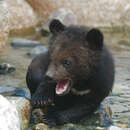en
names in breadcrumbs


Eutherians make up the largest of the three mammal lineages.This lineage is composed of all extant placental mammals (Placentalia) and all extinct nonplacental animals that are more closely related to the Placentalia than they are to other two mammal lineages.Metatheria (the marsupials) and Monotremata (the egg-laying mammals).
Of the approximately 5400 species of extant mammals, eutherians (placentals) make up 90%.All mammals endemic to the old world (Europe, Africa, Asia) and all but one species (the Virginia opossum, Didelphis virginiana) endemic to North America north of Mexico are placental mammals.Australia houses approximately the same number of placental mammals and marsupials.Most Australian placentals are species from the two most speciose placental orders: bats (Chiroptera) and rodents (Rodentia), which together make up almost half of all modern mammal species.Australia is unique in that all monotremes live only on this continent.The mammal fauna of Central and South America is dominated by placental species, but also includes the approximate 100 species of placentals outside of Australia (Archibald 2005).23 species of mammal are currently native to Antartica, all are marine.These include seals, whales and dolphins.However, fossil eutherians discovered from Antarctica reveal that its historic climate supported a diversity of terrestrial mammals (Gelfo et al. 2015).
Several features distinguish eutherians from noneutherian mammals, including numbers of teeth (adult eutherians have three molars and five premolars whereas metatherians have four molars and three premolars; adult monotremes do not have teeth) and various features of their feet, ankles, and jaws (Archibald 2005; Wikipedia 2014).
The oldest known eutherian species is the 160 million year old Juramaia sinensis, an extinct non-placental insectivore known from an almost complete fossil discovered in 2011 from the Jurassic terrestrial shale Tiaojishan Formation of Liaoning province, China (Luo et al. 2011).Before Juramaia was discovered the earliest known eutherian fossil was Eomaia, which dated the Eutherian origin to the considerably more recent (125 million year old) cretaceous.Genetic studies support the date of the eutherian-metatherian split at about 160 million years ago, and predicted the existence of a eutherian ancestor from this period even before the fossil was found; so the finding closes a significant evolutionary gap, gives new insight into the evolution of early mammals, and helps calibrate the mammalian molecular clock (Luo et al 2011; Wikipedia 2014).
This is a link to the classification of Eutherians.
Eutheria (/juːˈθɪəriə/; from Greek εὐ-, eú- 'good, right' and θηρίον, thēríon 'beast'; lit. 'true beasts') is the clade consisting of all therian mammals that are more closely related to placentals than to marsupials.
Eutherians are distinguished from noneutherians by various phenotypic traits of the feet, ankles, jaws and teeth. All extant eutherians lack epipubic bones, which are present in all other living mammals (marsupials and monotremes). This allows for expansion of the abdomen during pregnancy.[1]
The oldest-known eutherian species is Juramaia sinensis, dated at 161 million years ago from the early Late Jurassic (Oxfordian) of China.[2]
Eutheria was named in 1872 by Theodore Gill; in 1880 Thomas Henry Huxley defined it to encompass a more broadly defined group than Placentalia.[3]
Distinguishing features are:
Eutheria contains several extinct genera as well as larger groups, many with complicated taxonomic histories still not fully understood. Members of the Adapisoriculidae, Cimolesta and Leptictida have been previously placed within the outdated placental group Insectivora, while Zhelestids have been considered primitive ungulates.[6] However, more recent studies have suggested these enigmatic taxa represent stem group eutherians, more basal to Placentalia.[7][8]
The weakly favoured cladogram favours Boreoeuthearia as a basal eutherian clade as sister to the Atlantogenata.[9][10][11]
Eutheria Atlantogenata Boreoeutheria The fossil eutherian species believed to be the oldest known is Juramaia sinensis, which lived about 160 million years ago.[2] Montanalestes was found in North America, while all other nonplacental eutherian fossils have been found in Asia. The earliest-known placental fossils have also been found in Asia.[4]Other mammaliaformes
Mammals AustralosphenidsOther
Australosphenids
Eutheria
Eutheria (/juːˈθɪəriə/; from Greek εὐ-, eú- 'good, right' and θηρίον, thēríon 'beast'; lit. 'true beasts') is the clade consisting of all therian mammals that are more closely related to placentals than to marsupials.
Eutherians are distinguished from noneutherians by various phenotypic traits of the feet, ankles, jaws and teeth. All extant eutherians lack epipubic bones, which are present in all other living mammals (marsupials and monotremes). This allows for expansion of the abdomen during pregnancy.
The oldest-known eutherian species is Juramaia sinensis, dated at 161 million years ago from the early Late Jurassic (Oxfordian) of China.
Eutheria was named in 1872 by Theodore Gill; in 1880 Thomas Henry Huxley defined it to encompass a more broadly defined group than Placentalia.